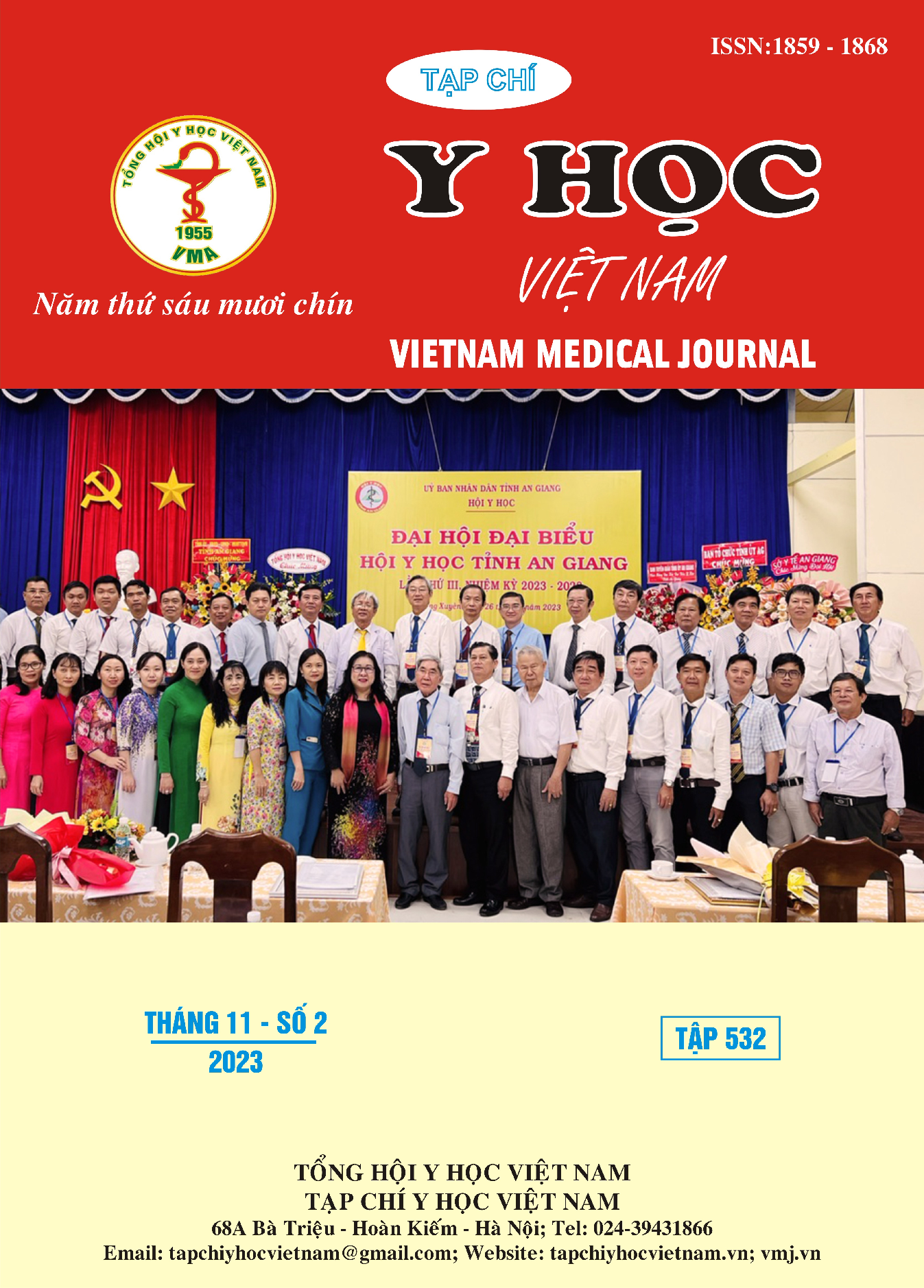SURGICAL OUTCOMES OF BLEPHAROPLASTY IN PATIENTS WITH SENILE BLEPHAROPTOSIS
Main Article Content
Abstract
Objectives: To describe the clinical features of senile blepharoptosis and to evaluate the surgical outcomes of blepharoplasty with levator aponeurosis advancement technique. Subjects and methods: A descriptive study of case series, including 20 patients with ptosis aged ≥ 40 years who underwent blepharoplasty with levator aponeurosis advancement technique at Hanoi Medical University Hospital and Bach Mai Hospital from January 2022 to March 2023. Result: The average age was 50.4 years old, in which 40-49 year-olds accounted for the highest percentage (60%). The patients in our study were all female. The majority of patients appeared bilateral ptosis, including
18 patients (90.0%). There was a difference in the rate of ptosis severity between different groups of levator muscle function with p < 0.05. The weaker the levator muscle, the higher the degree of ptosis severity. In a total of 38 eyes in 20 patients, all of them had looseness of the upper eyelid skin (excess skin). Anthropometric parameters (Vertical fissure width, marginal reflex distance, Margin crease distance, Levator Palpebrae Superioris action) were improved after surgery and 3 months follow-up. Patient satisfaction was 91.4% according to the FACE- Q scale. The average total scores when assessing the scar according to the POSAS scale of the patient and the observer are 9.1 and 7.3, respectively, showing favourable aesthetic results. Conclusion: Senile blepharoptosis in the study is mainly mild and there is a negative correlation between levator muscle function and severity of ptosis. Blepharoplasty patients are getting younger with the most common group was between 40-49 of age. High rates of patient
satisfaction without complications suggests that blepharoplasty with levator aponeurosis advancement technique offers a safe, effective, and reliable option for correction of senile blepharoptosis.
Article Details
Keywords
ptosis, levator muscle function, severity of ptosis, POSAS, FACE-Q
References
2. Edmonson BC, Wulc AE. Ptosis evaluation and management. Otolaryngol Clin North Am. 2005;38(5):921-946. doi:10.1016/j.otc.2005.08.012
3. Patel SM, Linberg JV, Sivak-Callcott JA, Gunel E. Modified tarsal resection operation for congenital ptosis with fair levator function. Ophthal Plast Reconstr Surg. 2008; 24(1):1-6. doi:10.1097/IOP.0b013e31815e72a3
4. Klassen AF, Cano SJ, Grotting JC, et al. FACE- Q Eye Module for Measuring Patient-Reported
Outcomes Following Cosmetic Eye Treatments. JAMA Facial Plast Surg. 2017;19(1):7-14. doi: 10.1001/ jamafacial.2016.1018
5. Draaijers LJ, Tempelman FRH, Botman YAM, et al. The patient and observer scar assessment scale: a reliable and feasible tool for scar evaluation. Plast Reconstr Surg. 2004;113(7): 1960-1965; discussion 1966-1967. doi: 10.1097/ 01.prs.0000122207. 28773.56
6. Akkaya S. Evaluation of Surgical Outcomes, Patient Satisfaction, and Potential Complications after Blepharoplasty. Beyoglu Eye Journal. 2018;3(2):91-95. doi:10. 14744/bej.2018.08208
7. Tyers AG, Collin JR. Senile ptosis--introduction and anterior approach. Trans Ophthalmol Soc U K (1962). 1985;104 (Pt 1):11-16.
8. Phan Thị Tám. Đánh Giá Kết Quả Điều Trị Sụp Mi Tuổi Già Tại Bệnh Viện Đa Khoa Tỉnh Bắc Kạn. Luận văn Bác sĩ chuyên khoa II. Trường Đại học Y Hà Nội; 2017.
9. Mehta HK. Day surgery management of senile ptosis. Trans Ophthalmol Soc U K (1962). 1985;104 ( Pt 2):171-175.
10. Parsa FD, Wolff DR, Parsa NN, Elahi aE E. Upper eyelid ptosis repair after cataract extraction and the importance of Hering’s test. Plast Reconstr Surg. 2001;108(6):1527-1536; discussion 1537- 1538. doi: 10.1097/ 00006534-200111000-00014


